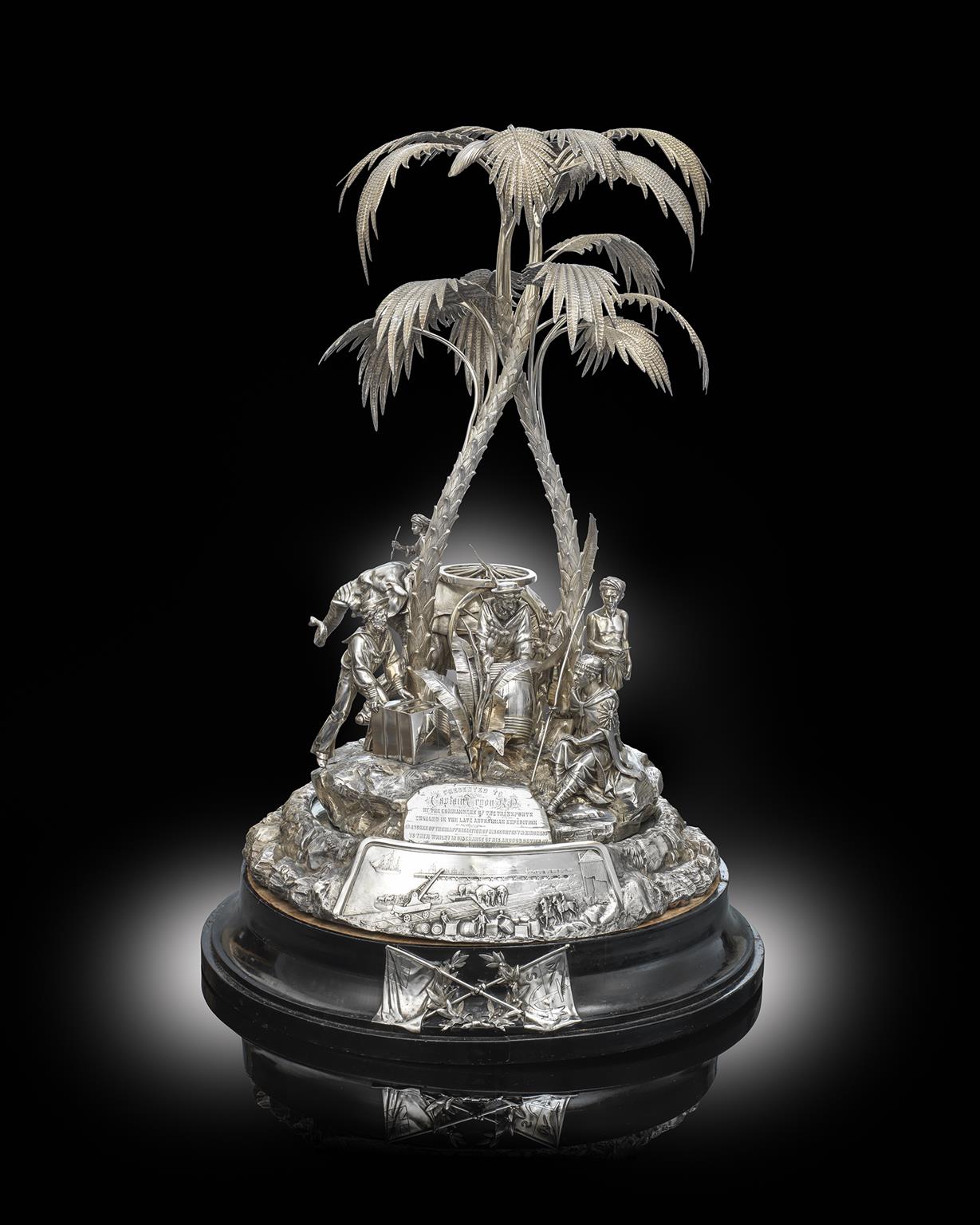Fine Silver & Objects of Vertu - 25th April 2018
Lot 877
A fine Victorian silver presentation centrepiece
Estimate £30,000 - £40,000
+ Buyers Premium
Description

A fine Victorian silver presentation centrepiece,
by Frederick Elkington for Elkington and Co, Birmingham 1868,
with two central inter-twined palm trees, mounted on a rocky base, the base mounted with two sailors moving a barrel and chest, with two men in native dress, one seated with a spear, and with two tobacco plants and an elephant carrying three wagon wheels, with a presentation plaque inscribed:
' Presented to Captain Tryon, R.N, by the Commanders of the Transports engaged in the late Abyssinian Expedition as a token of their appreciation of his courtesy & Kindness to them whilst in Discharge of his Arduos Duties at Annesley Bay, As principal Agent of Transports Afloat', on a rocky mirror plateau base, of shaped circular form, the back cast with solders attacking a village on a rocky outcrop, the front with a port scene of elephants, mules, cattle, barrels and chests being unloaded with ships in the distance, on an ebonised wooden plinth mounted with two ribbon-tied crossed flags, the naval ensign and a flag with an anchor and 'M.M.S.A', for the Mercantile Marine Association, height on plateau 70cm, total height on wooden plinth 81cm, approx. weighable 272oz. (8.53kg).
George Tryon (1832-1893) attended Eton College before becoming a naval cadet in 1848, and was promoted to Lieutenant in 1854 and then to Commander in 1860 and the Captain in 1866. Tryon then spent eighteen months away from ships. Aside from time on half pay on leave, he attended the Royal Naval College at Portsmouth to study steam technology. In August 1867 while touring Norway on a fishing expedition, he received a recall and appointment as 'additional captain' to HMS Octavia. Octavia was the flagship of the East India Station commanded by Commodore Leopold Heath. Tryon was attached to Octavia, but his duties were to act as transport officer at Annesley Bay, which was to be used as a staging post for troops and supplies for Sir Robert Napier's expedition to Abyssinia.
Tryon arrived in Bombay on 10 October 1867 where preparations were already underway. 291 transport ships were chartered, mainly from Bombay but some coming from England via the Cape of Good Hope. The advance party went to Zoulla in Annesley Bay in November, described as one of the hottest places on earth. The expedition delivered a fighting force of 4,000 men to Magdala out of total 13,000 soldiers and 60,000 people involved all together. 36,000 animals, mainly for transport, had to be taken to Zoulla. There was no drinking water, so 30,000 tons had to be distilled by the ships' steam engines using 8,000 tons of coal in the process, with ships held at anchor with their engines running. Tryon's duties involved early morning meetings ashore with military authorities, days spent unloading and organising ships, and evenings spent in preparation for the next.
Tryon was commended for his organisational skills and tact in dealing with all the disparate parties and complaining ships' captains. Approximately half his staff was invalided out because of the heat during the six months' stay, with the rest all suffering. When he left he was presented with a scroll recording the appreciation of his efforts by the captains of the transport fleet, and later in England was presented with a specially commissioned dinner service decorated with scenes commemorating the campaign.
The Service of Plate, specially designed by Elkington, commemorative of some of the principal events of the Abyssinian expedition, was subsequently presented to Captain Tryon at Liverpool, on which occasion Mr Graves on behalf of the Mercantile Marine Association, addressed him in suitable terms, to which Tryon made a graceful and modest reply. He was given the Companionship of the Bath by her majesty as a reward for his services.
He later became an Admiral, and set a very high standard for the manoeuvring of ships and fleets. This was ultimately what killed him, because a complex manoeuver went wrong, and H.M.S. Camperbown and Victoria collided, the latter sinking with him onboard.
Ref. Wikipedia, and Penrose Fitzgerald, C., Life of Vice-Admiral Sir George Tryon, William Blackwood and Sons, 1908, pages 96-97.